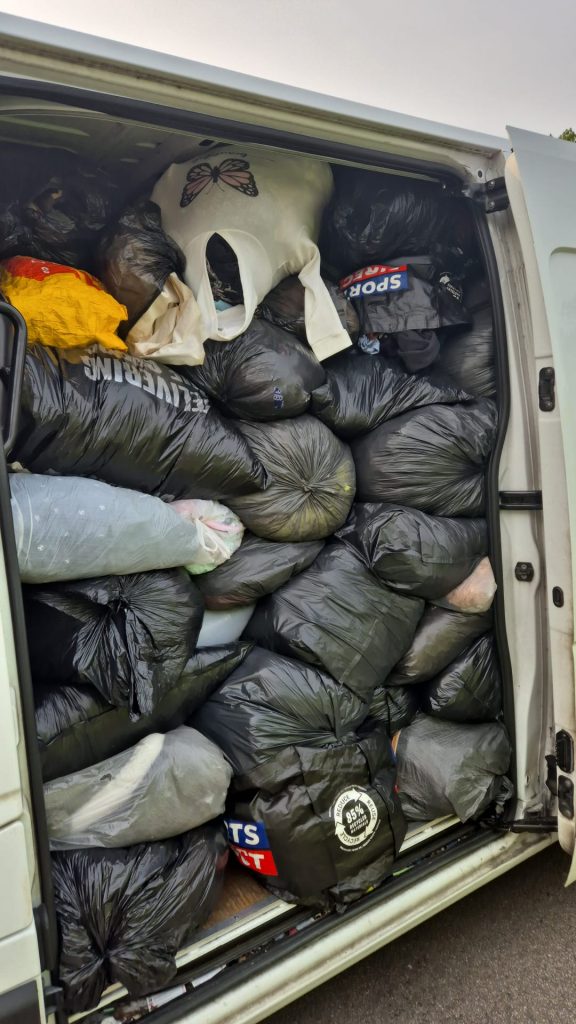In the UK, when it comes to donating unwanted clothes, two popular options stand out: clothing banks and charity shops. Both methods play crucial roles in recycling textiles and supporting charitable causes, but they operate differently and have distinct advantages. This article compares these two donation methods to help you make an informed decision about how to give your pre-loved items a new life.
Convenience and Accessibility
Clothing Banks
- 24/7 Access: Clothing banks are typically available round-the-clock, allowing donations at any time.
- Wide Distribution: Often found in easily accessible locations like supermarket car parks and community centers.
- Quick Drop-off: Ideal for quick, no-fuss donations without human interaction.
Charity Shops
- Limited Hours: Operate during specific business hours, which may not suit everyone’s schedule.
- High Street Presence: Usually located in town centers or busy shopping areas.
- Personal Interaction: Allows for face-to-face engagement with staff or volunteers.
Types of Items Accepted
Clothing Banks
- Primarily Textiles: Focus mainly on clothing, shoes, and other fabric items.
- Less Selective: Generally accept a wider range of textile conditions, including items suitable for recycling rather than resale.
- Bulk Donations: Well-suited for large amounts of clothing.
Charity Shops
- Diverse Items: Accept a wider range of donations beyond just clothing, including books, electronics, and household items.
- Quality Focus: Prefer items in good condition suitable for resale.
- Seasonal Acceptance: May have limitations on seasonal items or storage capacity.
Processing and Distribution
Clothing Banks
- Bulk Processing: Items are collected in large quantities and sorted at central facilities.
- Mixed Destinations: Donations may be distributed to various channels including resale, recycling, and international aid.
- Less Local Control: The final destination of items is often determined by larger organizations or recycling companies.
Charity Shops
- Local Processing: Items are usually sorted and priced on-site.
- Direct to Sales Floor: Suitable donations often go directly to the shop floor for resale.
- Community Impact: Profits typically support local community initiatives or specific charity programs.
Environmental Impact
Clothing Banks
- Efficient Collection: Bulk collection can be more fuel-efficient.
- Recycling Focus: Greater emphasis on recycling textiles unsuitable for resale.
- Potential for Export: Some clothing may be exported, which has both positive (supporting developing economies) and negative (carbon footprint of transportation) impacts.
Charity Shops
- Local Reuse: Promotes local reuse, reducing transportation-related emissions.
- Selective Acceptance: May lead to fewer items being accepted for recycling.
- Education Opportunity: Staff can educate donors about sustainable fashion practices.
Financial Benefits to Charities
Clothing Banks
- Lower Operational Costs: Require less manpower and physical space to operate.
- Bulk Sales: Generate revenue through bulk sales to recyclers or second-hand clothing exporters.
- Shared Profits: Often operated by third-party companies who share profits with charities.
Charity Shops
- Higher Profit Margins: Can price items individually, potentially generating more revenue per item.
- Gift Aid: UK taxpayers can boost their donations through Gift Aid, increasing the value to the charity.
- Direct Profit: All profits go directly to the charity, without third-party involvement.
Social Aspects
Clothing Banks
- Anonymous Giving: Provides a way to donate without direct interaction, which some prefer.
- Less Community Engagement: Limited opportunity for social interaction or community building.
Charity Shops
- Community Hubs: Often serve as social spaces and community meeting points.
- Volunteer Opportunities: Provide volunteering options for local community members.
- Personal Touch: Allow donors to explain the history or significance of items if desired.
Traceability of Donations
Clothing Banks
- Less Transparent: It can be harder to trace where exactly your donations end up.
- Varied Destinations: Items may be sold, recycled, or sent abroad, depending on quality and demand.
Charity Shops
- More Visible: Donors can often see their items for sale in the local shop.
- Specific Causes: Easier to donate to specific causes by choosing relevant charity shops.
Conclusion
Both clothing banks and charity shops play vital roles in the recycling and reuse of textiles, each with its own strengths. Clothing banks offer convenience and are great for bulk donations, potentially reaching a wider range of end-uses including recycling. Charity shops, on the other hand, provide a more personal donation experience, support local communities directly, and offer a wider range of items for resale.
The best choice depends on your personal circumstances, the items you’re donating, and your specific goals. For quick, convenient disposal of clothes, especially in large quantities or of varying quality, clothing banks are ideal. For a more personal touch, to support specific local causes, or to donate a variety of items beyond just clothing, charity shops are the way to go.
Ultimately, both methods contribute positively to sustainability and charitable causes. The most important thing is that usable items are given a second life rather than ending up in landfill. Whether you choose a clothing bank or a charity shop, your donations can make a real difference.



